Janet Hulstrand's Blog, page 15
March 26, 2019
Back Home in Essoyes…
Nature’s Sweet Welcome Home
Well, after six weeks away–nearly a week in Paris in February, followed by five weeks in Washington–I am back home in Essoyes.
And it is very good to be home again.
That is not to say that my time away was bad, not at all!
I always love time spent in Paris. (“I’m always just a little bit happier when I’m in Paris,” is how I think of it.) This time in addition to all the usual enjoyable diversions, I got to see a dear old friend who was there at the same time I was quite by accident. How wonderful it was to see him, and have a chance to catch up on our lives, and the news of our families!
Then I had a wonderfully rich, productive, interesting, and fun few weeks spent in the Washington D.C. area.
This time I was there (once again) primarily to deal with the unending saga of The Storage Locker That Will Not Be Emptied. I have ceased to be embarrassed about this, and have decided to be grateful instead. Not only has that storage locker allowed me to hold onto some very special things–mostly personal papers, photographs, etc. that I need for my work, along with some precious family memories–but it has also forced me to return to Washington every year or so for at least a few weeks. And that time has allowed me to deepen friendships I left behind, and even make some new friends.
I’m grateful to so many people for the kindness and generosity they extended to me in a variety of ways during my time there: more specific thanks will be coming to them in the days and weeks ahead. For now I’ll just say that among other highlights of my time there I was able to reconnect with my dear “Frenchies” (the French conversation group I started seven years ago, still going strong); teach two classes at Politics and Prose Bookstore (one about “getting along” in France, the other a mini Writing from the Heart session); and enjoy a “Demystifying the French” book signing party that some very kind friends hosted for me a few days before I returned to France.
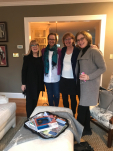
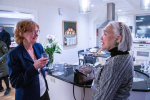



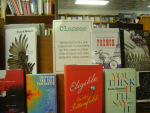
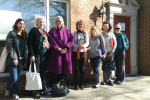
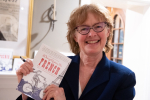

I am truly a bit overwhelmed by it all. I don’t really feel deserving of such kindness, generosity, and enthusiasm about my book: but I am very grateful for it.
There were plenty of sweet solitary moments also, moments of taking breaks from the drudgery of going through boxes of old letters and photos, during which I came to discover some of the charms of suburban Virginia: and enjoyed some sunsets on warm spring evenings, the lovely sounds of children playing in the background as I walked. (Sunsets are beautiful pretty much everywhere, you know?)
[image error]
Sunset in Arlington, Virginia
But, as I said. I’m back home now.
Last night I went to a meeting in the village hall where the citizens of Essoyes were beginning the planning for an exciting summer of celebrating the centenary of the death of Pierre Auguste Renoir. Essoyes is one of the places where the great painter and his family loved to spend time, and the family home here is now beautifully restored and open to the public. There will be much more to come about this soon…stay tuned…
After the meeting I walked home, heading into a beautiful, quiet, pinkish sky; past fields of wheat that can only be that kind of green in early spring.
And it was very lovely.
Janet Hulstrand is a writer, editor, writing coach, and teacher of writing and of literature who divid es her time between the U.S. and France. She teaches “Paris: A Literary Adventure” for the City University of New York each summer, and her next writing workshop will be held in Paris this summer. She is the author of Demystifying the French: How to Love Them, and Make Them Love You . She is currently working on her next book, a literary memoir entitled “ A Long Way from Iowa.”
March 5, 2019
Demystifying the French, in the U.S. and in France
So my new book, Demystifying the French: How to Love Them, and Make Them Love You, is now available in France, hooray!
[image error]
Penelope Fletcher at The Red Wheelbarrow has my book!
If you’re in Paris you can buy it at the wonderful indie bookstore The Red Wheelbarrow, in a lovely location right across the street from the Luxembourg Gardens. (How perfect is that? Go to a lovely little bookstore, buy some great books from friendly, sympathetic, super-intelligent Penelope Fletcher, then go across the street to find a chair and read in one of the best places to read in the world!)
If you’re in Washington D.C. you can buy it at my favorite bookstore in the U.S., Politics and Prose (they also ship books!)
And if you’re not able to get to a bookstore, you can buy it online, either from my publisher BookBaby, or from other sources online.
The book has been out now for almost six weeks, and it’s getting some great press. I’ll be teaching my Parlez-Vous Anglais? Survival French and French Travel Tips class this Saturday at Politics and Prose, and the following Saturday, a mini Writing from the Heart workshop.
While I was here, I met with a group I’m very fond of that I call “my Frenchies.” This is a conversation group I started at Politics and Prose about seven years ago, and it’s still going strong (though no longer at the store). They honored me with my first official book event at one of their meetings. I read from my book in English (of course!) and then we discussed it in French. Here they are!
[image error]
What everyone over here wants to know is: What do the French think about your book?! And now that it is available in France, I’m eager to learn the answer to that question. I hope “the French” will like it, and will recognize my deep love and admiration for this country and its people, despite the fact that I have poked fun at a couple of little things about them in the course of describing our cultural differences (I poked plenty of good-natured fun at Americans too!) None of us are perfect…right?
Anyway. I’ll soon be back in Essoyes. And though it has been very good to be here, I’m looking forward to being back home again too.
Janet Hulstrand is a writer, editor, writing coach, and teacher of writing and of literature who divides her time between the U.S. and France. She leads writing workshops in Essoyes, a village in the Champagne region, and teaches “Paris: A Literary Adventure” for the City University of New York each summer. This summer she will be leading a writing seminar in Paris in partnership with Politics and Prose bookstore. She is currently working on a literary memoir, A Long Way from Iowa.
January 27, 2019
January in Essoyes (2019)
Eglise Saint Rémi, Essoyes
I have always found churches with closed and locked doors, churches that are no longer being used, churches that are no longer open to the public, a sad thing.
To me churches are places for people to celebrate, or mourn, or seek solace. Places for them to gather in community, or kneel alone in prayer. Places they can go to when they don’t know where else to go to gather strength, or wisdom, or courage, or comfort. And sometimes to express gratitude, or joy.
Like most country churches–at least in France and in the U.S., the only two places I know well–these days our church in Essoyes is closed most of the time. It has to be: as a friend eloquently summed it up one day, “Il n’y a pas assez des fidèles. (“There aren’t enough of the faithful”) to keep it open. There are no regular masses, only occasional ones, held on a rotating basis, led by a priest shared with other nearby villages.
But at least in Essoyes the church is still being maintained, and it is still used from time to time, for weddings, for concerts, for funerals.
This month I found myself inside the church on three separate occasions–two of them large public events that filled the church with people–once with people mourning, once with them celebrating. The other time I found myself inside the church completely alone, not exactly seeking solace, but finding it anyway.
The first time was on the morning of January 2, when a funeral service was held for Micheline Cintrat–a much beloved, longtime member of the community who had died on Christmas Day. I wrote about her, and the service for her that filled the church that day, here.
The second time was a few days later, on January 6, which is the church celebration of the Epiphany, sometimes known as the twelfth day of Christmas, and in Mediterranean countries, including France, known as “Three Kings Day.”
I had noticed that the church doors were ajar a few days earlier when I drove past it: this is unusual, though not unheard of. I wondered idly why they were open, but I didn’t think too much about it. Later that day I read that the church was going to be open every afternoon until January 6, so that people could go inside and see the crèche, the nativity scene. I made a note to do so, but almost forgot to do it. Luckily, I remembered before it was too late. I went there on the afternoon of Epiphany itself, the last day the crèche would be on display until next year, and this is what I saw. [image error]
I didn’t expect there to be music, but there was: religious Christmas songs being sung in French were softly being played through speakers. Completely alone in the sanctuary, I approached the crèche and spent a few minutes in the first pew, kneeling, enjoying the light streaming in through the windows, the peacefulness, the beautiful music; reflecting on the hopefulness of the Christmas story, thinking about how far short we have fallen of reaching anything like peace on earth. Offering up a somewhat feeble prayer that somehow we could finally, at long last, do better; and trying to suppress the inevitable thought that we never ever will. And, despite the persistence of this probable and depressing reality, I left the church feeling a little bit of that “peace that passeth understanding,” words that were drilled into my head as a child coming back to me now, meaning a slight bit more than they did then.
The third occasion was last night, when I was fortunate to be able to attend a celebration of St. Vincent. St. Vincent is the patron saint of vignerons (wine makers), and there are celebrations all around France at this time of year, led by the brotherhoods (confrereries) of vignerons. Our local celebration began in the church at 5:00 p.m., and the church was once again filled with people, this time to celebrate the excellent and abundant crop of grapes that were gathered this year; to honor and perpetuate knowledge of the traditional practices of making champagne; and to express gratitude for that part of success in winemaking that is due to something beyond all the skill and hard work that goes into it. You can call it luck, or you can call it a divine blessing. But whatever you call it, that part is beyond human control.
It began with a procession of members of the Confreries of the vignerons of Essoyes, as well as from Noé les Mallets and Loches, two nearby villages. They were dressed in traditional clothing, and there were many children involved, including one wide-eyed, and very well-behaved baby who was proudly strolled down the aisle by children not many years older than him.
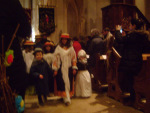
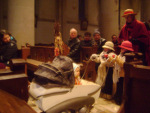

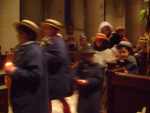
After the ceremony there was a vin d’honneur —an expression that has wide and diverse specific meanings, but in this case meant a celebratory toast–in the community center, followed by a dinner/dance. I stayed for the vin d’honneur during which the highlights of the previous year were summarized and plans for the coming year were briefly outlined; and several members of the confrereries were given recognition for special achievements or service.
Then the bottles were opened, and the celebration began in earnest. I did not stay for the dinner/dance, so I can’t report on that part of the festivities. However, I can say that the spirit in the room was very convivial when I left. And, knowing France as I do, I am sure that the food was excellent; that the conversation was lively; and that the champagne continued to flow freely for well into the night.
I can’t think of a better way to close this post than with a quote from the program for the church service last night:
Saint Vincent…que le joie inonde notre monde comme la douce pluie irrigue nos ceps! Et si quelqu’orage gronde, que notre pardon et notre humour triomphent!
(Saint Vincent…would that joy would flood our world, like the gentle rain that waters our vines…And if storms strike, would that our forgiveness and our good humor triumph!)
Janet Hulstrand is a writer, editor, writing coach, and teacher of writing and of literature who divid es her time between the U.S. and France. She leads writing workshops in Essoyes, a village in the Champagne region, and teaches “Paris: A Literary Adventure” for the City University of New York each summer. She is the author of Demystifying the French: How to Love Them, and Make Them Love You . She is currently working on her next book, a literary memoir entitled “ A Long Way from Iowa.”
Remembering Madame Cintrat…
“Nous avons bu nos paroles…” (“We have been drinking our words.”)
That is what stays with me the most from my first meeting with Mme. Micheline Cintrat (“Mimi” to her friends).
She said these words in response to the fact that in the course of an hour-and-a-half-long first conversation with her in the hotel bar where we had arranged to meet, she and my husband and I had been so instantly, so intently, and so throughly engaged in our conversation that he and I had entirely forgotten that it would probably be polite to offer her something to drink. And the hotel owner, seeing how engaged we all were, had stayed discretely in the background assuming (I assume) that if we wanted to ask for something to drink we would do so. So it was that when we suddenly said, after an hour and a half (or so) “Oh my goodness! Would you like something to drink?” that was her response to our embarrassed apologies: “We were drinking our words…”
That was our first meeting with Mme. Cintrat, but it was certainly not the last. The meeting had actually been suggested and arranged by the hotel owner, who knew that we were hoping to offer art and writing workshops in Essoyes. “You have to meet Mme. Cintrat, then,” he said. And he had arranged for her to come to the hotel to meet us.
He was right to introduce us to her, because she was passionately interested in the arts, and even more interested in helping develop arts-related endeavors in Essoyes. She knew everyone, and she quickly went about introducing us to many people she felt could either help us, or whom we could help, assuming our plans went forward.
Through her we also met some of the people who became our best friends in Essoyes, and the best friends of our children, some of them members of her own family–and for that fact alone I will be eternally grateful to her.
Through the years she and I became good friends. For me she was the kind of friend with whom you could fall into a very stimulating intellectual, or sometimes philosophical, discussion with no effort at all. (The effort involved was in stopping the conversation and getting back to the mundane demands of daily life.)
But all good things must come to an end: and this year, on the evening of New Year’s Day, the church bells in Essoyes tolled. They were not pealing joyously, as they had that very morning, to welcome a new year: they were now tolling mournfully, because Mme. Cintrat had died on Christmas Day, and the funeral ceremony for her was to be held the next morning in the village church.
They rang for quite a long time…was it 89 times, one for each year of her life? I don’t know. Maybe.
They tolled again, and again for a long time, early the next morning, and they rang out again shortly before 10:00, to announce to villagers that the service was about to begin and call them to the church.
The church was packed with her friends, family, and members of the community, and all three of her sons–our mayor, Alain Cintrat, and his brothers Pierre and Laurent–paid tribute to her. So did her grandchildren, and it was quite moving to hear from them about this woman who had been such a life force not only in her family, but in her community as well.
Beautiful classical music filled the church in the beginning of the ceremony–I believe one of the pieces of music was “Air on the G String” from Bach’s 3rd Orchestral Suite. Another was most certainly Schubert’s Ave Maria, played by a live string bass, coming from the organ loft.
Then, during the time when that whole big church full of friends, family, and admirers was invited to file by the coffin and bless it with holy water, a lovely musical surprise occurred, as the church now suddenly filled with the sound of Piaf singing “Sous le ciel de Paris…” For Madame had been born and raised in Paris.
As the throng filed solemnly, respectfully past the casket, several other songs sung by Piaf followed, including Je ne regrette rien, which made me smile–because surely Mme. Cintrat was, among many other qualities, a woman who did not indulge in regret. There is a memento of her in our house, a piece of cardboard with these words inscribed on it in her handwriting: “Je ne cherche pas, je trouve (I don’t seek, I find). Picasso.” It was one of the quotes by artists that she and other villagers had created to decorate Essoyes at the time of the annual art fair some years ago. I don’t remember how it got into our house: I must have either asked her if I could have it, or perhaps she gave it to us thinking we needed that sort of encouragement. It would have been just like her to do something like that.
A day or two after the funeral, as I walked into the village I realized that having heard all those testimonies from her family, having learned the things I had not known before about her life, having heard the music she loved fill the church that day had–for me anyway–brought her, in a strange but very palpable kind of way, back to life again.
I had been to see her now and then, whenever I could, after she suffered a stroke a little bit more than four years ago. She had responded somewhat to my being there, and that was somewhat rewarding. But she was not herself, or rather, if she was, she was no longer able to express herself in such a way that those of us who cared for her could really be sure of what she was trying to tell us. It was very frustrating and painful for everyone who went to see her, and I’m pretty sure for her as well.
I realized that for the first time since that time, I felt that her energy, her passion, her dynamism, her zest for life, had been restored–that her family had succeeded, through the ceremony they had carefully prepared and shared with all of us, to bring her back to life after that long and painful illness, in a very real way. That what had felt like a void in the life of this village over the past few years had been filled once again. This was a surprising, a curious, and a very welcome feeling.
I rarely remember my dreams, and when I do they are usually pretty vague in their details and quickly forgotten. But that night I dreamt about her so vividly: I dreamt that she had been brought back to life, really. I saw her so clearly in my dream!
In the dream, her strength and health had been restored; she was sitting by her husband André’s side, holding hands with him. They both looked very peaceful and content.
And she was regretting nothing.
Janet Hulstrand is a writer, editor, writing coach, and teacher of writing and of literature who divid es her time between the U.S. and France.
January 21, 2019
Book Review: The Gardener of Eden by David Downie
[image error]
David Downie is primarily known as a food, wine, and travel writer, but this is not his first work of fiction. Paris: City of Night, a thriller set in Paris, was published in 2009. (And I interviewed him about that book here.)
The publisher of his latest book, The Gardener of Eden, has described it as a work of literary crime. The author himself, in his blog describes it as a work of “literary suspense.” I will leave it to you to determine which of those two descriptions is the more accurate. But I can concur with other reviewers in saying that it is indeed a dark tale with plenty of unsettling suspense. (I had a hard time maintaining my cool especially toward the end: it is gripping!)
Despite the fact that normally it is hard to get me to read (and especially to review) anything that is not set in France (a function not so much of my close-mindedness as the frustrating lack of time available to do everything one would like to do), such is my admiration for Downie’s writing that of course when provided with an advance copy I couldn’t say no. And I found myself drawn into the story very quickly indeed, despite the fact that it is set in coastal California, not France. The first chapters introduce three of the main characters, who are all very compelling; and their quirky relationships and the clever repartée that passes between them is so lively and entertaining that I was quickly and thoroughly engaged.
While it is true that the story hinges on some deeply disturbing observations of contemporary American culture, one of the main things that moved me while reading it was indeed its literary quality. Downie is both a masterful writer, able to describe complicated, breathtaking sequences of physical action with accuracy (this is very hard to do!) and a very lyrical one. Here’s just one example of what I mean about the latter:
A stand of mature blue gum trees rose ghostly and shivering into the mist along an unpaved access road topping the cliffs. Beyond a clump of honey-scented purple buddleia and clotted blue ceanothus, James made out the banisters of a wooden staircase. It was lichen frosted, bleached, and sandblasted by the wind. Zigzagging down to the rocks and beach, it ended in knotted clumps of wind-burned, brittle flowering ice plants dangling from the sandy verge. The air smelled of salt and skunk, honey and eucalyptus, bay leaf and cypress. James closed his eyes and felt tears welling up.
There are many such poetic, sensually precise, evocative passages woven into the story. It is not the only reason why this is such a pleasant read, despite the overall darkness of the tale: but it is one of them.
I have admired David Downie’s work for some time: he is an intelligent, graceful writer capable of doing with words almost anything you need them to do: his work is always very interesting and is energized by a passionate undercurrent, whether overtly expressed or subtly and elegantly woven into the story. In Gardener of Eden he is at the top of his game: word has it that he is working on his next novel. I can hardly wait to read it.
Janet Hulstrand is a writer, editor, writing coach, and teacher of writing and of literature who divid es her time between the U.S. and France. She leads writing workshops in Essoyes, a village in the Champagne region, and teaches “Paris: A Literary Adventure” for the City University of New York each summer. She is the author of Demystifying the French: How to Love Them, and Make Them Love You . She is currently working her next book, a literary memoir entitled “ A Long Way from Iowa.”
January 18, 2019
Demystifying the French
Thank you so much, Sara Somers, for this wonderful chance to tell people about my new book, Demystifying the French. I’m so glad you liked it and found it helpful. Janet

As I told you in my last blog about la politesse, while finishing it up, my friend, Janet Hulstrand, asked me if I would read and review her latest book: Demystifying the French. How to Love Them and Make them Love You (What you’ve heard about them is not entirely true….). I love reading most anything and, as it turned out, this was a very special read. I learned a lot. The book is small and can be read quickly. You can earmark pages you want to return to and give more thought to it. I highly recommend that anyone visiting France for the first or the twentieth time, read this book. I think that means I give it five stars!
The book is broken down into two parts. The first part is made up of what she calls: Essential Tips for Even Very Brief Encounters. Saying Bonjour is…
View original post 1,852 more words
January 8, 2019
Announcing “Demystifying the French”
[image error]
C’est parti! Here we go!
I am SO HAPPY to announce that my new book, Demystifying the French: How to Love Them, and Make Them Love You, is now available for preordering or purchase.
You can learn more here. Please wish me luck, everyone!
Janet Hulstrand is a writer, editor, writing coach, and teacher of writing and of literature who divid es her time between the U.S. and France. She leads writing workshops in Essoyes, a village in the Champagne region, and teaches “Paris: A Literary Adventure” for the City University of New York each summer. She is currently working on a literary memoir, “ A Long Way from Iowa.”
January 1, 2019
Bonne Nouvelle Année d’Essoyes (2019)
[image error]Well it is that time of year again. The shortest days of the year are behind us now, and every day the sun will be with us for a little bit longer…yay!!!
On the first Sunday in December, we were treated to a concert in the community center: three local chorales performing Christmas songs. It was a lovely way to head into the darkest days of the year. It is lovely to see people everywhere, whether in small rural communities or small communities within large cities, making time to practice and preserve such traditions, and to share them with their neighbors.
I left the concert a bit early to be sure that I could make it home before dark: and as I walked home I was reminded of what I had told some of my friends when I first started spending more time here, to explain why I love it so much. “I just love the walls,” I said. “When I walk into Essoyes to buy bread in the morning, and I walk by those ancient walls, I just feel good. It’s hard to explain why something so simple makes me feel so good, but it does.”
Here are (some of ) the walls I’m talking about, as seen toward sunset on a semi-dreary day in early December. I think it is something about the suggestion of permanency, of a long history lived here in this village that makes me feel so good, even though I know that much of the history has not been something anyone would want to live through.
[image error]
It has been wonderful to have one of my sons and his friend Anna here with me for the holidays. They came from Paris on the train a few days before Christmas, and I picked them up at our closest stop, in Vendeuvre-sur-Barse. No matter how you approach Essoyes, or from what direction, there is so much beauty to be seen. The route from Vendeuvre to Essoyes has a somewhat more dramatic open landscape, and fewer villages, than the route from Troyes. But they are both beautiful drives. I particularly love the giant windmills atop a high plateau that we drive over on our way home from Vendeuvre: not only because they are in and of themselves such beautiful shapes but because I know they are providing energy in a more sensible, more sustainable way than some of the other ways we’ve counted on in the past. It makes me feel like at least in some places some things are getting better, not worse!
I have held off saying anything about the gilets jaunes until now, hoping that the movement would have come to a more or less satisfactory resolution, and that it would be fairly easy to summarize and explain. Alas, neither the movement, nor the complaints of the gilets jaunes are anything like “resolved” and nothing about it lends itself to easy summary or interpretation. Indeed there are troubling signs that the usual suspects who tend to take advantage of moments of civil unrest–and perhaps some unusual suspects as well this time–are not about to calm down, but are instead intent on wreaking havoc and sowing discord among the people. It is a very complicated situation, and I am not going to try to describe or explain it here: there has been a lot of ink spilled on the topic by people who know far more about it than I do, and in any case it’s not over yet.
Most of the trouble has been in the cities, but the movement is largely a rural movement being brought there by people who feel they have for too long not been listened to. What I will say is that I hope, along with most French people, as well as most nonFrench people living in France, whether they are “pro,” “anti” or somewhere in the middle regarding the gilets jaunes, that the discontent, and the real problems that led to so many ordinary citizens to feel fed up enough with their government to engage in some very committed and sustained, and unfortunately upsetting-for-everyone protests, will be adequately addressed by the government, so that peacefulness can once again prevail. President Macron gave his annual New Years vouex (wishes, or greeting) to the nation last night and so far it seems that many approve of what he had to say. Of course not everyone does, and everyone would agree that there is much hard work to be done in the weeks and months ahead in order for France to come through this period of turbulence, reestablish harmony, and make the changes needed for a more just, more equitable future for all.
We went to the Christmas Eve mass at a lovely little 16th century church in Merrey-sur-Arce, and as the priest asked for blessings and protection upon the police and other public servants in his prayers, I heard the man next to me in the pew murmur “et les gilets jaunes..” I thought it was a good thing to remember them too.
Hunting season is in full swing in the French countryside, and that means that weekends bring the frequent sound of gunfire, of dogs barking, and even of bugles. (Yes! Bugles! 
November 26, 2018
End-of-Autumn Thoughts…
Essoyes on a misty morning. Photo by Janet Hulstrand
One of the things I love the most about Essoyes is its relative proximity to Paris. At just two and a half hours away, one can do a round trip in a day, which I do from time to time. The last time I went to Paris, I stayed for five days, and that was pretty nice too! I was grateful to be able to talk about downsizing the family home, the subject of my first book, at my friend Adrian Leeds’s Apres-Midi meet-up in the Marais on November 13. After that I was able to stay on in Paris for a few days, which allowed me to spend some time with my son, and attend a very interesting discussion at the American Library in Paris. I was also really happy to be able to visit the newly reopened Red Wheelbarrow bookstore, on the rue de Medicis, just across from the Luxembourg Gardens, and to meet Penelope Fletcher, a wonderful, and much beloved member of the Anglophone literary community. I had interviewed Penelope a few weeks earlier for Bonjour Paris: that interview is here.
While I was in Paris, the palette changed from late Indian summer to early winterish tones. The change of season and of colors was noticeable too, on my ride back home from Troyes to Essoyes; and when I walked up the path from our driveway to the house the abundance of leaves on the ground announced the approach of winter.
One of the things I learned upon my return to Essoyes was the sad news that Bernard Pharisien, our beloved local historian and Renoir scholar, had passed away. His burial was last Thursday in the village cemetery, and a large crowd gathered to pay him their respects. He will be sorely missed!
It is an interesting thing about Thanksgiving. Americans abroad cling to it, and take it with them wherever they go. My Facebook feed was full of excited sharing of recipes and pictures of beautifully set tables, desperate questions about substitute ingredients, cooking instructions and the like, from American friends in Europe. Perhaps this is because Thanksgiving is one of our best national holidays. It is certainly my favorite: it is spiritual without being specific to any one religion; it is noncommercial in the main (especially if one chooses to ignore or reject the attempts to commercialize it); it is fundamentally about simple gratitude and being together with family and friends, giving thanks for all our blessings, and sharing them with others.
I was lucky to be able to celebrate Thanksgiving this year with a wonderfully mixed group of American, French, and British friends at the home of the one other American in Essoyes this weekend. (Most Americans in France celebrate the holiday on the weekend following Thanksgiving, since the fourth Thursday in November is simply the fourth Thursday in November here.) For several of the guests it was their first experience of an American Thanksgiving, and part of the fun for the Americans was explaining what the holiday means to us, how it came about, how it is celebrated, and so on. My friends allowed me to read aloud to them one of my favorite Thanksgiving poems, and gave the cardboard pilgrims that have been with me at so many Thanksgivings, from Brooklyn to Washington DC, to Silver Spring, a place from which they could overlook the celebration, which made it complete for me. (It was the cardboard pilgrims’ first Thanksgiving in Essoyes 
November 23, 2018
A Fond and Sad Farewell to Bernard Pharisien, Beloved Son of Essoyes
[image error]
I had difficulty suppressing the irrational thought, as I made my way to the cemetery in Essoyes yesterday, for the burial ceremony of M. Bernard Pharisien–Essoyes’s beloved historian, raconteur, researcher, teacher, generous sharer of all he learned–that surely he would be there.
But of course, in a way he was.
Some people, when they leave this world, leave not so much a void as a palpable and enduring presence. So it is with M. Pharisien, I believe.
He gave so much to this little village, the village of his birth and childhood, the village to which he remained devoted all his life. And through his indefatigable, constant, and continuing research into the history of Essoyes and some of its famous sons (and daughters!) he gave much to the existing knowledge of the Renoir and Heriot families as well.
That his work, and his generosity, were deeply appreciated was clear yesterday: many, many cars lined the streets of the village near the cemetery, and there was a large crowd there to pay him their respects: people from all walks of life, and apparently from both near and far.
Everything he learned in his research–which was basically a second career for him, a passionate pursuit that he began after his retirement as a teacher–he shared so generously with the public. Until last summer he gave his matinale walking tours through the village, four days a week, all summer long, each tour typically lasting at least three hours. In these walking tours he enthusiastically shared the stories he had collected, and the knowledge he had gained, with anyone who wanted to listen. He did not charge anything for these talks: he hoped that people would buy his books, but they were not obliged to, and he never pressured anyone to do so. I went on a few of these walks and every time I did I learned a lot, because every time I did he had learned a lot since the last one I had attended.
He knew a lot of interesting facts, but it was his ability as a storyteller that was so engaging. There was never anything dry or boring about the history of Essoyes as related by M. Pharisien. His sense of humor and irony, though tending to be understated, enlivened his presentations. As I stood in the cemetery yesterday listening to the eulogies presented by the mayor, M. Pharisien’s former colleagues, and members of his family, my eyes fell on the very unusual (and beautiful) statute of the nude woman, a work of local artist Louis Morel, and on the grand monument to the Heriot family. Each of these monuments to the dead had been stops on M. Pharisien’s tours and the bits of history and local lore that he recounted there have made them forever more meaningful to me.
He is now buried right next to the towering monument to the Heriot family where he shared his knowledge so often, so freely, and so well. (I say this so that those who find their way back to Essoyes and want to pay tribute to M. Pharisien when they are here will know where to look.)
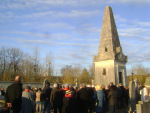


Mr. Pharisien left this world suddenly, unexpectedly, and in my mind way too soon. At 80 years of age, he seemed to be still in the prime of his life. I saw him leaning in for a conversation with someone idling a car on one of the village streets not long ago.
He will be missed so much. It is really too bad he is gone. But oh, what a wealth of valuable work he has left behind! Thank you, thank you so much, M. Pharisien, for all you have done to honor, record, and share the history of this village with us, and with the world.
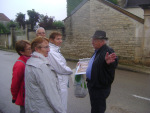
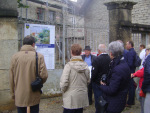


Merci, M. Pharisien. Vous nous manquerez beaucoup. Mais on essaierai de continuer d’apprendre, de respecter, de garder, et d’apprécier l’histoire de ce petit village que vous avez tant aimé.
Janet Hulstrand is a writer, editor, writing coach, and teacher of writing and of literature who divid es her time between the U.S. and France. You can read her interview with M. Pharisien, in English and in French, here.




